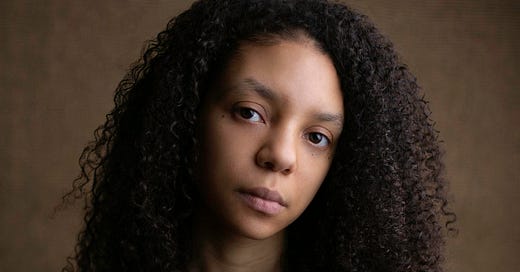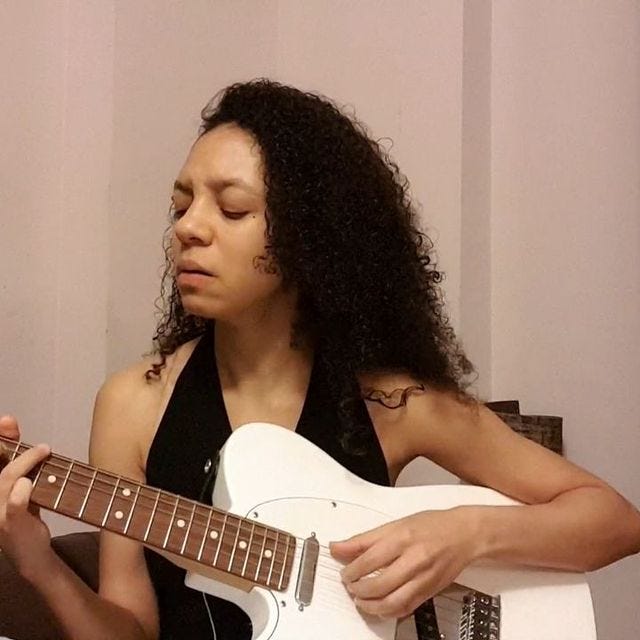Simeon Hammond Dallas: “There’s strength in not being put into boxes”
The singer on defying expectations, insufficient language and her musical influences
Hi, welcome back to Mixed Messages! This week I’m speaking to Simeon Hammond Dallas, who is of Black, English and Welsh heritage. Simeon is one of 40 people in the inaugural year of the PRS Foundation’s POWER UP network, an initiative launched to address anti-Black racism and racial disparities in the music sector. Representing Black talent across the UK, from all different genres, I’m excited to speak to mixed-Black participants over the next few weeks. First up, country-soul singer Simeon.
How do you define your ethnicity?
My mum is white-English and Welsh, and my dad is Black British, with parents from the Windrush generation. Growing up, it was very ‘Black and proud’. I only thought about being mixed at school, when people asked questions about where I was from. Then it suddenly became ‘you’re half-this and half-that.’ That always felt weird to me.
I normally describe myself as Black, but I do call myself mixed-race because my experience is not the same as a Black person’s. I’m conscious of that.
Did you speak about race with your family?
We spoke about it, but there was no nuance. My dad faced extreme racism in the ‘70s and ‘80s, so he wanted to instil a sense of pride in us for our Jamaican culture and make sure we knew Black history.
It’s a lot harder to be proud of a side of you that has been an oppressor to your other side. My mum shied away from her English side, she had racist family members who didn’t want her to have children who looked like me.
Do people have an expectation of your musical style based on how you look?
Yeah. I gravitated to folk, probably because I play acoustic guitar, but I refuse to hang out in folk clubs now – there’s always a white guy who calls me Tracy Chapman.
My dad used to play Alanis Morissette, The Cranberries and Rickie Lee Jones in the house. I also remember listening to Sam Cooke and Marvin Gaye, stuff that gets you in the gut! 2004 Kelly Clarkson’s Breakaway probably got me into country, and I also went through an emo phase – I just didn’t want to choose a genre.
Is that resistance to labels a part of your personality?
There’s a running theme there, or maybe the childhood trauma of not wanting to choose one thing. I remember telling my parents ‘I don’t know what to pick!’ when filling out forms. I was adamant that I wasn't white and Black Caribbean, not half-this and half-that. I’m one thing.
I think there’s a strength in saying ‘I’m not going to be put in a box,’ but there’s also a loneliness to it. As a kid, you just want to fit in and not be an outcast. I went through a phase of wanting to either be Black or white. I was bullied based on my looks, which was hard when my female role models didn’t have skin or hair like me.
Did you consciously seek out mixed communities?
No, but I’ve always felt a lightness in those spaces. I went to university in Chester, where students had never seen Black people before. I had to navigate conversations I thought I was done with, but people were actually listening this time. I have time for people who listen, but anyone who wants to play devil’s advocate, I cut those conversations off. You can’t call me a mongrel and get away with it.
Did you see anyone mixed who resonated with you when you were younger?
I struggle to think of anyone who I saw when I was growing up – I did love Mariah Carey, but she didn’t look like me. I only realised she was mixed from a Buzzfeed article.
Today, there’s not a specific person, but there’s more representation generally of everyday life, like that Sainsbury’s advert that caused so much controversy.
How do you think the conversation about mixed identity needs to change?
I don’t think any term fully embodies my experience, and I think whatever you label yourself as has stereotypes alongside it. I can’t get across my whole nuanced identity in a way that’s palatable and succinct enough for people to hear and then move on with their lives.
What’s the best thing about being mixed?
Feeling comfortable in a lot of situations, and being allowed to be lots of different things. Not facing contention for what I enjoy.
Can you sum up your personal mixed experience in one word?
Delicate.
Next week, I’ll be talking to Adem Holness, Music Curator at the Horniman Museum. Subscribe to get Mixed Messages in your inbox on Monday!
Enjoy Mixed Messages? Support me on Ko-Fi so I can continue to grow this newsletter! My new goal is to pay a mixed writer to create a special first anniversary edition of Mixed Messages.
Mixed Messages is a weekly exploration of the mixed-race experience, from me, Isabella Silvers. My mom is Punjabi Indian (by way of East Africa) and my dad is White British, but finding my place between these two cultures hasn’t always been easy. That’s why I started Mixed Messages, where each week I’ll speak to a prominent mixed voice to delve into what it really feels like to be mixed.







